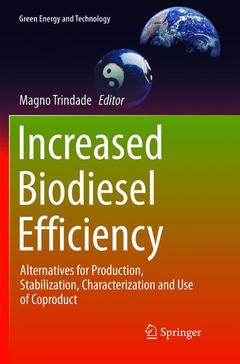Description
Increased Biodiesel Efficiency, Softcover reprint of the original 1st ed. 2018
Alternatives for Production, Stabilization, Characterization and Use of Coproduct
Green Energy and Technology Series
Coordinator: Trindade Magno
Language: English
Subjects for Increased Biodiesel Efficiency:
Publication date: 06-2019
186 p. · 15.5x23.5 cm · Paperback
Publication date: 02-2018
Support: Print on demand
Description
/li>Contents
/li>Biography
/li>Comment
/li>
Prof. Dr. Magno Aparecido Gonçalves Trindade is a chemistry graduate (2002) and has a master’s degree in chemistry (2005) from the Federal University of Mato Grosso do Sul (UFMS), and a Ph.D in analytical chemistry from the University of São Paulo State (UNESP, 2009). He was a postdoctoral fellow in analytical chemistry at the UNESP (2009–2010) and UFMS (2010) before joining the Federal University of Grande Dourados (2010) as an assistant teacher of analytical chemistry. His scientific interests include biodiesel, electrochemistry methods and sample preparation for biofuel and fuel application. The focus of his biofuel research is alternative multifunctional additives to improve the stability (more efficiently and more cost-effective) of biodiesel or its blends. He is currently investigating electrochemistry methods and sample preparation for biologic and environmental applications. He is the author and co-author of more than 40 articles, two books and three patents on these subjects.
Explains how to overcome the economic challenges of biodiesel production
Shows how to cut the cost of synthesis
Demonstrates the cutting-edge tenchnologies used in characterisation




